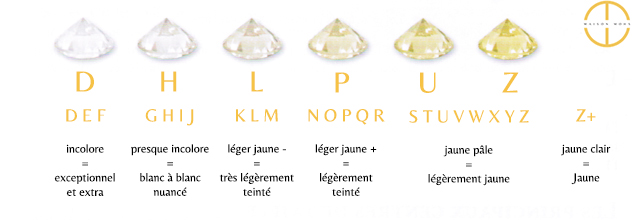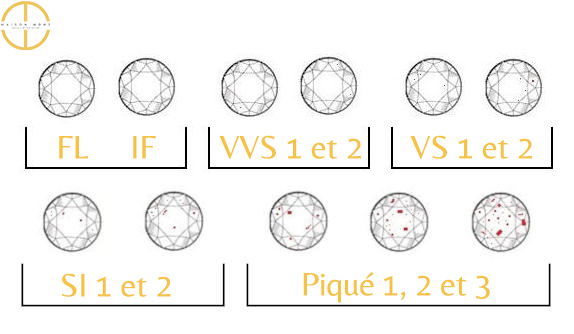
Physical Characteristics of a Diamond
Composition of a Diamond
A raw diamond consists of pure carbon (C) and forms under very high temperature and pressure in the Earth’s mantle.
Although composed primarily of carbon atoms, raw diamonds may contain other substances such as boron (B), nitrogen (N), inclusions of graphite, aluminum (Al), silicon (Si), calcium (Ca), magnesium (Mg), iron (Fe), and more.
These substances can sometimes be solid, recognized by the presence of visible inclusions in the diamond, or they may be invisible and contribute to the diamond’s color. For instance, boron (B) can give a diamond a blue color.
Structure of a Diamond
Diamonds are gemstones with a cubic crystalline structure and take the form of an octahedron when found in nature. During their formation, carbon (C) atoms arrange themselves to form a cube (see the diamond crystal structure below).
Diamond Hardness
To characterize the hardness of a gemstone, the mineralogist Friedrich Mohs invented a scale in 1812 that allows us to measure mineral hardness. The Mohs scale starts at 1, with talc being the softest mineral, and goes up to 10, with diamond being the hardest natural material in the world. However, diamonds are still fragile and can cleave into several pieces if struck precisely on one of their cleavage planes.

Other Characteristics of Diamonds: Refraction, Density, Thermal and Electrical Conductivity, and Coloration
Additionally, diamonds are excellent thermal conductors, with a particularly high refractive index (2.4), providing them with incredible light dispersion.
White or colorless diamonds are the most well-known. As mentioned earlier, imperfections can give diamonds various colors, including yellow, blue, blue-gray, black, red, green, pink, and more.
Natural diamonds can be transparent, translucent, or opaque. Some diamonds exhibit blue fluorescence under ultraviolet light.
Where Can Diamonds Be Found?
Diamond-Producing Countries
Diamonds are primarily produced in the following countries: Russia (Oudatchaïa kimberlite mine), Canada (Ekati kimberlite mine), Botswana (Orapa mine), and South Africa (Finch mine).
Extraction and Trade
Diamonds are extracted from mines of three different types of deposits: primary deposits (in open-pit or underground mines), secondary alluvial deposits, and marine coastal deposits.
Primary Diamond Deposits
Diamonds form in the Earth’s crust, approximately 150 kilometers deep, under extreme pressure (50 kbar) and temperatures (1100°C). These gemstones are surrounded by a magma called “kimberlitic magma.” This magma follows currents in our Earth’s mantle and sometimes initiates movements toward the surface, which can accelerate. The violent speed of this movement carries and tears gems and rocks along its path through a pipe, thus bringing diamonds to the surface. Several volcanic eruptions can take the same pipe. For example, it is known that the Premier Mine in South Africa experienced 15 eruptions.
Diamonds from these primary deposits are extracted through open-pit (and sometimes underground) mining. The pipe is dug and exploded gradually to find diamonds trapped in the surrounding rock. Consequently, benches are created along the pipe, forming concentric circles through which trucks pass to extract rocks in fragments. These rocks are then treated and sieved to recover diamonds.
Once the diamonds are extracted, they are sorted and classified based on their quality and size. Larger and higher-quality diamonds are more sought after and will be sold at higher prices. After the diamonds are sorted and classified, they are sent to diamond exchanges, where they are bought and sold by traders from around the world.
Secondary Diamond Deposits
After being expelled through a pipe, a diamond can sometimes continue its journey due to the natural erosion of the volcano by weathering. Diamonds can be transported and deposited in “alluvial” deposits, sometimes in a riverbed or on the seabed. For example, Namibia’s marine soils are mechanically excavated, recovering the equivalent of 500,000 carats of diamonds each year.
What Does the Term “Carat” Mean?
The term “carat” is used to determine a diamond’s weight. One carat is equivalent to 0.2 grams and is used to compare a diamond’s weight to that of other diamonds of the same size (the way it was cut). The heavier a diamond, the rarer it is, and therefore, the more expensive.
How Is the Price of Diamonds Determined?
The price of diamonds is determined based on specific evaluation criteria known as the “4Cs”: color, carat weight, clarity, and cut.
Color: A white diamond is a colorless diamond that is appreciated based on the following terms: exceptional white (absence of color), extra white, white, nuanced white, slightly tinted, tinted, yellow.

Completely yellow diamonds are considered fancy color diamonds and are measured on a different color scale.
Carat: Carat is a unit of measurement for a diamond’s weight. A 1-carat diamond weighs 0.2 grams. Diamonds over 0.50 carats are considered rare.
Clarity: A diamond is evaluated based on its visible purity under 10x magnification or the naked eye, ranging from “flawless” (without inclusions) to “inclusion” (visible inclusion).

Cut: A diamond’s cut is evaluated based on how it is shaped to maximize its brilliance (play of light within the diamond). The proportions of the cut parts of the diamond are assessed. For example, old-cut diamonds reflect less light than brilliant-cut diamonds, which is why old-cut diamonds are significantly less expensive.
Thus, based on these quality criteria, the heavier, completely colorless, inclusion-free, and brilliantly cut a diamond is, the more valuable it is.
How to Get a Diamond Appraisal?
Diamonds are often passed down as heirlooms or given as gifts, such as for a wedding or another special occasion. It can be challenging for the recipient to know the true value of this precious stone. Evaluating a diamond requires expertise. You need to be a gemologist to assess the four criteria mentioned above, to obtain a certificate from an accredited gemological laboratory, and to know the intrinsic value of your diamond.
Getting a certificate from a recognized independent laboratory is beneficial for several reasons:
- In case of theft: The certificate can be provided to your insurance company.
- In case of sale: The certificate serves as the diamond’s identification card, highlighting its qualities.
If you have a diamond that you want to appraise because of its significant size (over approximately 0.80 carats), don’t hesitate to contact us. Maison Mohs has its own on-site gemologist. In the initial phase, we can provide you with an estimated price range. Then, following the creation of an authenticity certificate (which takes about a week to complete at an independent laboratory), detailing the diamond’s characteristics (color, weight, purity, and cut), we can refine its potential selling price and provide you with the information you need.
These articles related to the theme of diamonds might also interest you:
Which Ring to Choose for a Marriage Proposal?
How to Select an Engagement Ring?
How to Identify a Diamond on a Ring?
Where to Get an Antique Jewelry Appraised?
In the same field, we also invite you to read “Everything You Need to Know About Precious Stones.”
